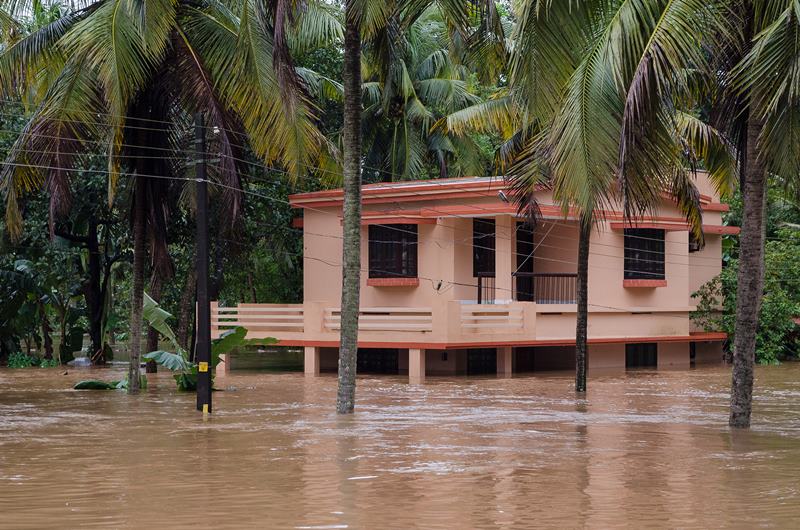WATCH: Why do Kerala and Uttarakhand face frequent heavy rain related disasters — a senior climate expert explains
Be it inundating floods or pulverising landslides, the frequency with which the states of Kerala and Uttarakhand have been contributing to news headlines in the last few years is astonishing. Here, at Gaon Cafe, Madhavan Rajeevan, former secretary in the Union Ministry of Earth Sciences explains what makes these states prone to disasters.

“Things are changing, we should frankly accept,” were the words with which Madhavan Rajeevan, a noted meteorology expert and former secretary in the Union Ministry of Earth Sciences described the frequent extreme weather events along India’s western coast, of which the flood-hit Kerala is a part of.
In the latest episode of Gaon Cafe which was anchored by Nidhi Jamwal, Deputy Managing Editor, Gaon Connection, the weather expert explained the reasons due to which the states of Kerala and Uttarakhand regularly witness disasters which wreak havoc on the lives of thousands of people.
“When I was in my training in 1985, I remember our teacher used to say that the north Arabian Sea is much cool (sic), nothing (cyclone) would form, even if it forms it immediately fizzles out. But that is not the case anymore. The Arabian Sea is warming as compared to the Bay of Bengal and the warm ocean is very dangerous,” the expert said.
“It’s almost like a heat engine. It can induce low-pressure systems (eg. cyclones, depressions). Now, we have cyclones forming in the Arabian Sea regularly which has not been before,” he added.

Also Read: Heavy rainfall leads to flooding in Kerala; at least 24 reported dead, rescue operations underway
But as per the expert, merely heating up of the oceans as a direct result of global warming is not the only cause of extreme flooding which disrupts normalcy in the coastal state of Kerala.
“We need a detailed study of the local factors in order to have a better understanding of reasons that contribute to the frequency of floods and the resulting landslides which cause deaths in Kerala,” Rajeevan said while pointing at the lack of substantial meteorological research in the country.
However, the expert also talked about changes in land use patterns in Kerala that have increased the chances of casualties during landslides.
‘Uttarakhand’s topography fragile, difficult to save lives despite weather warnings’
Talking of the recent floods and deadly landslides in the Himalayan state of Uttarakhand, Rajeevan stated that the inability to pinpoint the location and timing of the landslides results in casualties which are hard to prevent as of now.
As many as 46 people have lost their lives in the ongoing heavy rainfall, floods and landslides while at least 11 persons have been reported as missing.
“At present we do not have the science and technology to prevent landslides. Efforts are being made but it is yet to be achieved,” the expert said.
Also Read: Death toll due to heavy rainfall, flash floods and landslides in Uttarakhand rises to 46; 11 missing
However, talking about the extreme precipitation which leads to floods and increases the risk of landslides in the state’s young-fold mountains, Rajeevan said that the frequency of a weather phenomenon called ‘western disturbances’ is increasing due to the melting of polar ice caps in the Arctic.
Western disturbances are basically intrusive high-velocity winds that originate in Europe’s Mediterranean region which is responsible for the occurrence of sudden winter rain in the northern parts of the Indian subcontinent.

“But the manner in which these western disturbances are occurring, it is not only the northern parts of the country which are witnessing heavy rains. It is often seen that even states like Maharashtra are facing heavy rainfall due to the phenomenon,” he said.
“The problem is more severe in Uttarakhand as the topography there is very fragile. There is always the risk of landslides if there are heavy rains in the hills,” the expert added.
‘Number of rainy days is decreasing’
While explaining the changes in the monsoon weather system, Rajeevan said that it is a robust meteorological phenomenon and nothing will change suddenly but the amount of rainfall received is being restricted to a lesser number of days.
“What is happening is that now we are having fewer rainy days. It never happens that it rains throughout the monsoon season in any state. The rainfall magnitude is the same but what should have rained in 35-40 days is now raining in about 30 days or even 25 days,” he highlighted.
“This will have a lot of serious implications for the farmers,” the expert warned.

